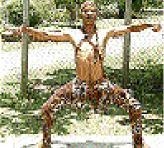A touch of Africa
Published: Saturday | June 27, 2009

Famous son: Most famous person to hail from Lucea: Sir Alexander Bustamante.
A diverse catalogue of settlers has occupied Jamaica's borders. From the original Taino natives to their Spanish conquerors, so many inhabitants have left their historical impressions on the Jamaican society.
However, it is the African slaves who became the dominant cultural power, surviving forced labour and harsh conditions. One group in particular left behind an everlasting taste of their culture, which is to this day, still performed by the people of Lucea.
ettu danced still performed

Ettu dancer
Dances of the Ettu are still practised in Lucea by those who claim to be direct descendants of the Ettu Nigerians who were brought to Jamaica between the 1500s and the 1800s from Africa. While dancehall remains the popular focus of Jamaican dance culture, the Ettu dance is performed at some wedding and funeral ceremonies, as well as festivals.
Dance performer, Marvin Drummond, believes that the performing arts is something the people of Lucea really enjoy doing because there is not a lot of social activity in the area.
"Dance provides an escape into another world," he said, adding that he often incorporated Ettu into many of his dance routines.
There are Ettu rituals and plays still in existence, but in Lucea, the Ettu dance is the most prevalent preservation of the Ettu people. During a ceremony, songs are performed by whole groups, accompanied by two drums, one of tin and one of double-headed goat skin (both are played with fingers). According to Drummond, throughout the dance, feet are flat and in constant contact with the ground. Men dance with high-energy movements, while women move their hips slowly in contrast to the men's extravagant displays.








